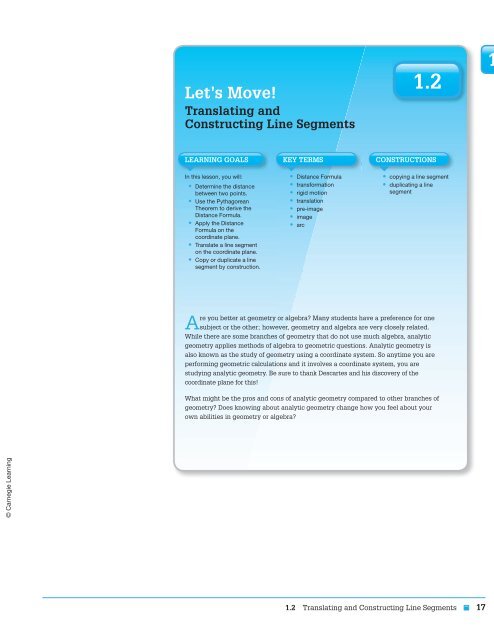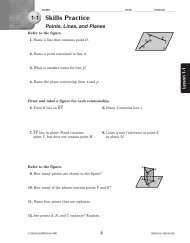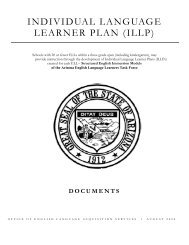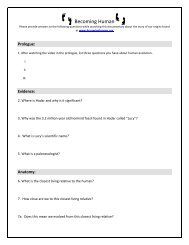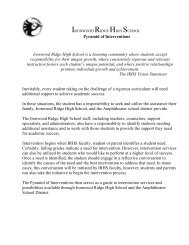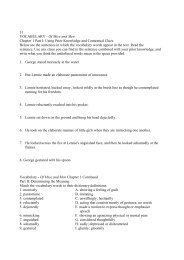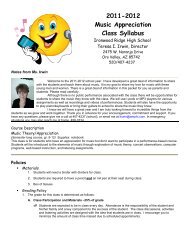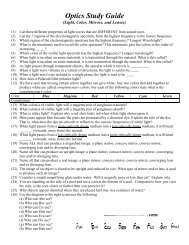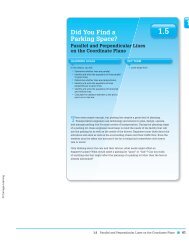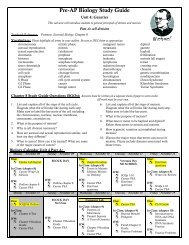Lesson 1.2
Lesson 1.2
Lesson 1.2
Create successful ePaper yourself
Turn your PDF publications into a flip-book with our unique Google optimized e-Paper software.
A Let’s Trip Move! to the MoonUsing Translating Tables and to RepresentEquivalent Constructing Ratios Line Segments1.1 <strong>1.2</strong>1LEARNING GOALS KEY TERMS KEY TERM CONSTRUCTIONSIn this lesson, you will: Distance Formula ratio Write Determine ratios the as distance part-to-part and part-towholebetween relationships. two points. rigid motion Represent Use the Pythagorean ratios using models. translation transformation Use Theorem models to derive to determine the equivalent ratios. pre-image image arc copying a line segment duplicating a linesegmentDistance Formula. Apply the DistanceFormula on thecoordinate plane. Translate a line segmenton the coordinate plane. Copy person or duplicate who weighs a line 100 pounds on Earth would weigh only about 40 pounds onsegment by construction.A the planet Mercury and about 91 pounds on Venus. In fact, there are only threeplanets in our solar system where a 100-pound person would weigh more than 100pounds: Jupiter, Saturn, and Neptune. On Saturn, a 100-pound person would weighabout 106 pounds, on Neptune, about 113 pounds, and on Jupiter, about 236 pounds!On Pluto——which is no longer considered a planet—–a 100-pound person wouldAweigh re less you than better 7 pounds. at geometry or algebra? Many students have a preference for onesubject or the other; however, geometry and algebra are very closely related.But what if a 100-pound person could stand on the surface of the Sun? If that wereWhile there are some branches of geometry that do not use much algebra, analyticpossible, then that person would weigh over 2700 pounds! More than a ton! Whatgeometry applies methods of algebra to geometric questions. Analytic geometry iscauses these differences in weight?also known as the study of geometry using a coordinate system. So anytime you areperforming geometric calculations and it involves a coordinate system, you arestudying analytic geometry. Be sure to thank Descartes and his discovery of thecoordinate plane for this!What might be the pros and cons of analytic geometry compared to other branches ofgeometry? Does knowing about analytic geometry change how you feel about yourown abilities in geometry or algebra?© Carnegie Learning<strong>1.2</strong> Translating and Constructing Line Segments 17
Problem 1The locations of friends’ housesare described using streetnames in a neighborhood laidout on a square grid. Studentswill determine the locationof each on the coordinateplane and calculate distancesbetween locations using eithersubtraction (for vertical orhorizontal distances) or thePythagorean Theorem (fordiagonal distances).GroupingHave students completeQuestions 1 through 10 witha partner. Then have studentsshare their responses as aclass.Guiding Questionsfor Share Phase,Questions 1 through 10• What are the coordinates ofDon’s house?• What are the coordinates ofFreda’s house?• What are the coordinates ofBert’s house?• Whose houses arehorizontally aligned?• Whose houses arevertically aligned?• Whose houses arediagonally aligned?• What expression is usedto represent the distancebetween Don’s house andBert’s house?• What expression is usedto represent the distancebetween Bert’s house andFreda’s house?PROBLEM 1 Where Do You Live?Don, Freda, and Bert live in a town where the streets are laid out in a grid system.1. Don lives 3 blocks east of Descartes Avenue and 5 blocks north of Elm Street. Fredalives 7 blocks east of Descartes Avenue and 2 blocks north of Elm Street. Plot points toshow the locations of Don’s house and Freda’s house on the coordinate plane. Labeleach location with the student’s name and the coordinates of the point.14131211109876543210yDescartes Ave.Bernoulli Ave.Agnesi Ave.Don(3, 5)Bert(3, 2)Fermat Ave.Euclid Ave.Elm St.1 2 3 4 5 6 7 8 9 10 11 12 13 14• What expression is used to represent the distance between Freda’s house toBert’s house and the distance from Bert’s house to Don’s house?• If Freda walks to Don’s house, is she walking a horizontal, vertical, ordiagonal distance?• Do the distances between Freda’s house, Bert’s house, and Don’s house forma right triangle? How do you know?• The distance between which two houses is represented by the hypotenuse?Kepler Ave.Hamilton Ave.(7, 2)Euler Ave.FredaGauss Ave.Leibniz Ave.a. Name the intersection of streets that Don lives on.Laplace Ave.WNSEChestnut St.Birch St.Mulberry St.Oak St.Catalpa St.Cherry St.Maple St.Pine St.Don lives at the intersection of Euclid Avenue and Oak Street.b. Name the intersection of streets that Freda lives on.Freda lives at the intersection of Euler Avenue and Maple Street.2. Bert lives at the intersection of the avenue that Don lives on, and the street that Fredalives on. Plot and label the location of Bert’s house on the coordinate plane. Describethe location of Bert’s house with respect to Descartes Avenue and Elm Street.Bert lives 3 blocks east of Descartes Avenue and 2 blocks north of Elm Street.3. How do the x- and y-coordinates of Bert’s house compare to the x- and y-coordinatesof Don’s house and Freda’s house?The x-coordinate of Bert’s house is the same as the x-coordinate of Don’s house.The y-coordinate of Bert’s house is the same as the y-coordinate of Freda’s house.x© Carnegie Learning18 Chapter 1 Tools of Geometry
4. Use Don’s and Bert’s house coordinates to write and simplify an expression thatrepresents the distance between their houses. Explain what this means in terms of theproblem situation.5 2 2 5 3Don lives 3 blocks north of Bert.15. Use Bert’s and Freda’s house coordinates to write and simplify an expression thatrepresents the distance between their houses. Explain what this means in terms of theproblem situation.7 2 3 5 4Freda lives 4 blocks east of Bert.6. All three friends are planning to meet at Don’s house to hang out. Freda walks to Bert’shouse, and then Freda and Bert walk together to Don’s house.a. Use the coordinates to write and simplify an expression that represents the totaldistance from Freda’s house to Bert’s house to Don’s house.(7 2 3) 1 (5 2 2) 5 4 1 35 7b. How far, in blocks, does Freda walk altogether?Freda walks 7 blocks.7. Draw the direct path from Don’s house to Freda’s house on thecoordinate plane. If Freda walks to Don’s house on this path,how far, in blocks, does she walk? Explain how you determinedyour answer.Let d be the direct distance between Don’s house andFreda’s house.d 2 5 3 2 1 4 2d 2 5 9 1 16d 2 5 25d 5 5Freda walks 5 blocks to reach Don’s house.this distance.What shapedo you see? Howcan that help youdetermine the distanceof the direct path?© Carnegie Learning<strong>1.2</strong> Translating and Constructing Line Segments 19
8. Complete the summary of the steps that you took to determine the direct distancebetween Freda’s house and Don’s house. Let d be the direct distance between Don’shouse and Freda’s house.Distance between Distance between Direct distance betweenBert’s house and Don’s house and Don’s house andFreda’s house Bert’s house Freda’s house2( 7 2 3 )21 ( 5 2 2 )5 d 24 2 1 3 2 5 d 216 1 9 5 d 225 5 d 25 5 dSuppose Freda’s, Bert’s, and Don’s houses were at different locations but oriented in asimilar manner. You can generalize their locations by using x 1, x 2, y 1, and y 2and still solve forthe distances between their houses using variables. Let point F represent Freda’s house,point B represent Bert’s house, and point D represent Don’s house.yD(x 2, y 2)F(x 1, y 1)B(x 2, y 1)9. Use the graph to write an expression for each distance.a. Don’s house to Bert’s house (DB)xSure, theycan live indifferent locations, butthe points must still form aright triangle in order forus to generalize this,right?DB 5 y 22 y 1b. Bert’s house to Freda’s house (BF)BF 5 x 22 x 1© Carnegie Learning20 Chapter 1 Tools of Geometry
10. Use the Pythagorean Theorem to determine the distance from Don’s houseto Freda’s house (DF).1DF 2 5 BF 2 1 DB 2DF 2 5 (x 22 x 1) 2 1 (y 22 y 1) 2DF 5 √ ___________________(x 22 x 1) 2 1 (y 22 y 1) 2You used the Pythagorean Theorem to calculate the distance between two points on thecoordinate plane. Your method can be written as the Distance Formula.The Distance Formula states that if (x 1, y 1) and (x 2, y 2) are two points on the coordinateplane, then the distance d between (x 1, y 1) and (x 2, y 2) is d 5 √ ___________________(x 22 x 1) 2 1 (y 22 y 1) 2 .y(x 2, y 2)The absolutevalue symbols areused to indicate thatthe distance is alwayspositive.|y 2– y 1|(x 1, y 1)|x 2– x 1|(x 2, y 1)x11. Do you think that it matters which point you identify as (x 1, y 1) and which point youidentify as (x 2, y 2) when you use the Distance Formula? Use an example to justifyyour answer.No. Once I square the differences, the values are the same so the order doesnot matter.For example, (3 2 5) 2 5 (22) 2 5 4 and (5 2 3) 2 5 2 2 5 4.© Carnegie Learning<strong>1.2</strong> Translating and Constructing Line Segments 21
GroupingHave students completeQuestions 12 through 14 witha partner. Then have studentsshare their responses as a class.Guiding Questionsfor Share Phase,Questions 12through 14• The value of the square rootof 29 is between what twowhole numbers?• Is the square root of 29closer to 5 or closer to 6?• The value of the square rootof 208 is between what twowhole numbers?• Is the square root of 208closer to 14 or closer to 15?• The value of the square rootof 65 is between what twowhole numbers?• Is the square root of 65closer to 8 or closer to 9?• How is Question 13 similar toQuestion 12 part (a)?• How would you describethis translation?• In Question 14, will morethan one value satisfy theDistance Formula?• Why do two different valuessatisfy the Distance Formula?NoteEncourage students toapproximate the value of asquare root without using acalculator by first identifyingwhat two whole numbers areclosest to the value of thesquare root, then estimating12. Calculate the distance between each pair of points. Round your answer to the nearesttenth if necessary. Show all your work.a. (1, 2) and (3, 7) b. (26, 4) and (2, 28)x 15 1, y 15 2, x 25 3, y 25 7 x 15 26, y 15 4, x 25 2, y 25 28d 5 √ _________________(3 2 1) 2 1 (7 2 2) 2 d 5 √ _____________________[2 2 (26)] 2 1 (28 2 4) 25 √ _______2 2 1 5 2 5 √ ___________8 2 1 (212) 25 √ _______4 1 25 5 √ _________64 1 1445 √ ___29 5 √ ____208¯ 5.4 ¯ 14.4The distance is about 5.4 units.The distance is about 14.4 units.c. (25, 2) and (26, 10) d. (21, 23) and (25, 22)x 15 25, y 15 2, x 25 26, y 25 10 x 15 21, y 15 23, x 25 25, y 25 22d 5 √ _______________________[26 2 (25)] 2 1 (10 2 2) 2 d 5 √ __________________________[21 2 (25)] 2 1 [23 2 (22)] 25 √ __________(21) 2 1 8 2 5 √ ___________[4 2 1 (21) 2 ]5 √ _______1 1 64 5 √ _______16 1 15 √ ___65 5 √ ___17¯ 8.1 ¯ 4.1The distance is about 8.1 units.The distance is about 4.1 units.which whole number the square root is closer to by choosing a value for the tenthposition. Also, students often overlook the possibility of a second solution whenworking with square roots. You may need to mention a possible negative andpositive solution in Question 14.© Carnegie Learning22 Chapter 1 Tools of Geometry
1?13. Carlos and Mandy just completed Question 12 parts (a) through (c). Now, they needto calculate the distance between the points (24, 2) and (22, 7). They notice thesimilarity between this problem and part (a).Mandyd 5 √ ___________________(24222) 2 1 (227) 2d 5 √ _____________(22) 2 1 (25) 2d 5 √ _____4125d 5 √ ___29d ¯ 5.4Carlos(24, 2)(22, 7)28 26 24 22 0228642y(1, 2)2(3, 7)468x242628(1, 2) → (24, 2) The point moved 5 units to the left(3, 7) → (22, 7) The point moved 5 units to the leftSince both points moved 5 units to the left, this did notalter the distance between the points, so the distancebetween points (24, 2) and (22, 7) is approximately 5.4.Who used correct reasoning?Both Mandy and Carlos used correct reasoning. Mandy’s work shows an algebraicsolution whereas Carlos’s work shows geometric reasoning.© Carnegie Learning14. The distance between (x, 2) and (0, 6) is 5 units. Use the Distance Formula to determinethe value of x. Show all your work.x 15 x, y 15 2, x 25 0, y 25 6, d 5 5d 5 √ ___________________(x 22 x 1) 2 1 (y 22 y 1) 25 5 √ _________________(0 2 x) 2 1 (6 2 2) 25 5 √ _________2x 2 1 4 25 2 5 ( √ _________2x 2 1 16 ) 225 5 x 2 1 169 5 x 223, 3 5 xThe value of x can be 23 or 3.<strong>1.2</strong> Translating and Constructing Line Segments 23
Problem 2The locations of friends’ housesare used to form a line segmenton a coordinate plane. Theterms transformation, rigidmotion, translation, image,and pre-image are introduced.Students will translate a linesegment into all four quadrantsof the graph and determinethe location of each on thecoordinate plane. They noticepatterns used when writing thecoordinates of the images andpre-image and conclude thattranslating a line segment doesnot alter the length of the linesegment. Translations preservethe length of a line segment.PROBLEM 2 Translating a Line Segment1. Pedro’s house is located at (6, 10). Graph this location on the coordinate plane andlabel the point P.See coordinate plane.2. Jethro’s house is located at (2, 3). Graph this location on the coordinate plane and labelthe point J.See coordinate plane.3. Draw a line segment connecting the two houses to create line segment PJ.J91612216 212 28 24 0P0 24J0P98428212yJ4J90P8P901216xGroupingHave students completeQuestions 1 through 4 with apartner. Then have studentsshare their responses as a class.Guiding Questionsfor Share Phase,Questions 1 through 4• Are Pedro’s and Jethro’shouse positioned in a verticalor horizontal distance fromeach other?• How would you bestdescribe the slope of theline segment formed byconnecting Pedro’s andJethro’s house?• The value of the squareroot of 65 is closest to whatwhole number?• Is the the square root of 65closer to 8 or closer to 9?• Which coordinates of the endpoints are the same if the line segment isdescribed as vertical?• Which coordinates of the endpoints are the same if the line segment isdescribed as horizontal?2164. Determine the length of line segment PJ.x 15 6; y 15 10; x 25 2; y 25 3d 5 √ ___________________(x 22 x 1) 2 1 (y 22 y 1) 25 √ __________________(2 2 6) 2 1 (3 2 10) 25 √ _____________(24) 2 1 (27) 25 √ ________16 1 495 √ ___65¯ 8.1___The length of PJ is about 8.1 units.Length isthe same asdistance on thecoordinate plane!© Carnegie Learning24 Chapter 1 Tools of Geometry
GroupingHave students completeQuestions 5 through 12 witha partner. Then have studentsshare their responses as a class.Guiding Questionsfor Share Phase,Questions 5 through 12• If the location of Pedro’s andJethro’s houses is translatedto the left, is that considereda negative or positivedirection? Why?• If the location of Pedro’s andJethro’s houses is translateddown, is that considereda negative or positivedirection? Why?• If the location of Pedro’sand Jethro’s houses istranslated to the right, is thatconsidered a negative orpositive direction? Why?• If the location of Pedro’s andJethro’s houses is translatedup, is that considereda negative or positivedirection? Why?• It can be said that throughtranslations line segment PJmaps onto itself, what doesthis mean?A transformation is the mapping, or movement, of all the points of a figure in a planeaccording to a common operation.A rigid motion is a transformation of points in space.A translation is a rigid motion that “slides” each point of a figure the same distance anddirection. Sliding a figure left or right is a horizontal translation, and sliding it up or down is avertical translation.The original figure is called the pre-image. The new figure created from the translation iscalled the image.5. Line segment PJ is horizontally translated 10 units to the left.a. Graph the image of pre-image PJ ___. Label the newpoints P9 and J9.See graph.b. Identify the coordinates of P9 and J9.The coordinates of P9 are (24, 10), and thecoordinates of J9 are (28, 3).6. Line segment P9J9 is vertically translated 14 units down.a. Graph the image of pre-image P9J9 ____.Label the new points P99 and J99.See graph.b. Identify the coordinates of P99 and J99.The coordinates of P99 are (24, 24), and thecoordinates of J99 are (28, 211).7. Line segment P99J99 is horizontally translated 10 units tothe right.a. Without graphing, predict the coordinates of P999 and J999.The coordinates of P999 will be (6, 24) and J999 willbe (2, 211).b. Graph the image of pre-image _____P99J99 . Label the new pointsP999 and J999.See graph.A line,or even a point,can be considered afigure.The primesymbol, like on P9or P 0, indicates thatthis point is related to theoriginal point P. P9 is readas “P prime” and P 0 isread as “P doubleprime.”1© Carnegie Learning<strong>1.2</strong> Translating and Constructing Line Segments 25
8. Describe the translation necessary on ______P999J999 so that it returns to the location of ___PJ .To return the line segment to the original location, I need to perform a verticaltranslation 14 units up.9. How do the lengths of the images compare to the lengths of the pre-images?Explain how you could verify your answer.The lengths of the images and the pre-images are the same. They are eachapproximately 8.1 units long.I could use the Distance Formula to verify that each line segment is the same length.10. Analyze the coordinates of the endpoints of each line segment.a. Identify the coordinates of each line segment in the table.Line Segments ___PJ____P9J9_____P99J99______P999J999Coordinates ofEndpoints(6, 10)(2, 3)(24, 10)(28, 3)(24, 24)(28, 211)(6, 24)(2, 211)b. Describe how a horizontal translation changes the x- and y-coordinates ofthe endpoints.A horizontal translation changes the x-coordinates of the endpoints, but they-coordinates remain the same.c. Describe how a vertical translation changes the x- and y-coordinates ofthe endpoints.A vertical translation changes the y-coordinate of both endpoints, but thex-coordinates remain the same.11. Describe a sequence of two translations that will result in the image and the pre-imagebeing the same.The image and the pre-image will be the same if I translate up, down, left, or rightand then translate in the opposite direction by the same number of units.12. Describe a sequence of four translations that will result in the image and the pre-imagebeing the same.Answers will vary.The image and the pre-image will be the same if I translate right by x units, down byy units, left by 2x units, and up by 2y units.© Carnegie Learning26 Chapter 1 Tools of Geometry
Problem 3Students are instructed howto use a compass to draw acircle. They will construct acircle using a given point asthe center and a given linesegment as the radius of thecircle. They then constructother radii in the same circleand conclude that all radii ofthe same circle are of equallength. In the next activity,the term arc is defined. Givena line segment, students willconstruct an arc using theline segment as a radius andone endpoint as the centerof the circle. They concludethat all of the points on the arcare the same distance to thecenter of the circle, and all ofthe line segments formed byconnecting a point on the arcto the center point of the circleare the same length. Studentsuse congruent circles to createa hexagon. Students are giventwo congruent circles and useconstruction tools to duplicatecongruent radii. They willconclude radii of congruentcircles are congruent.PROBLEM 3 Copying Line SegmentsIn the previous problem, you translated line segments on the coordinate plane. The lengthsof the line segments on the coordinate plane are measurable.In this problem, you will translate line segments when measuring is not possible. This basicgeometric construction is called copying a line segment or duplicating a line segment.You will perform the construction using a compass and a straightedge.One method for copying a line segment is to use circles. But before you can get to that, let’sreview how to draw perfect circles with a compass.Remember that a compass is an instrument used to draw circles and arcs. A compass canhave two legs connected at one end.One leg has a point, and the other holds a pencil. Some newer compasses may be different,but all of them are made to construct circles by placing a point firmly into the paper and thenspinning the top of the compass around, with the pencil point just touching the paper.1. Use your compass to construct a number of circles of different sizes.Take yourtime. It may takea while for you to beable to construct a clean,exact circle withoutdoubled or smudgedlines.1© Carnegie LearningGrouping• Ask a student to read thedefinitions. Discuss thecontext and completeQuestion 1 as a class.• Have students completeQuestions 2 and 3 witha partner. Then havestudents share theirresponses as a class.<strong>1.2</strong> Translating and Constructing Line Segments 27
Guiding Questionsfor Share Phase,Questions 2 and 3• What is a radius?• What do you know about allradii of the same circle?• What do you know about allradii of congruent circles?• How is a circle related to anarc of the circle?• How many radii are used tocreate an arc?• How many arcs are ina circle?• How many points determinean arc?• How is the center of thecircle used to create an arc?• How are radii used to createan arc?2. Point C is the center of a circle and ___CD is a radius.a. Construct circle C.ACBFDEb. Draw and label points A, B, E, and F anywhere on the circle.c. Construct AC ___, BC ___, EC ___, and FC ___.d. Shawna makes the following statement about radii of a circle.ShawnaRemember acircle is a set of all pointsin a plane that are the same distancefrom a given point called the center ofthe circle. A radius is a segment drawnfrom the center to a point onthe circle.All radii are the same length, because all of the points of a circle are equidistant fromthe circle’s center.Explain how Shawna knows that all radii are the same length? Does this mean theline segments you constructed are also radii?Shawna knows that the radii are the same length because the distance from thecenter to any point on the circle is the same distance. So, any segment drawnfrom the center to a point on the circle will have the same length.Yes. The other line segments are radii of the circle because they are linesegments that extend from the center of the circle to an endpoint on the circle.An arc is a part of a circle. You can also think of an arc as the curve between two pointson the circle.3. Point C is the center of a circle and ___AC is the radius.a. Construct an arc of circle C. Make your arc about one-half inch long. Construct thearc so that it does not pass through point A.EBAb. Draw and label two points B and E on the arc and construct ___CE and ___CB .Cc. What conclusion can you make about the constructed line segments?The constructed segments must have the same length as ___AC because every pointon the arc is the same distance from C as A is.© Carnegie Learning28 Chapter 1 Tools of Geometry
GroupingHave students completeQuestion 4 with a partner.Then have students share theirresponses as a class.Guiding Questionsfor Share Phase,Question 4• What does it mean to say toline segments are congruent?• How could you show twoline segments are congruentusing a compass?• How do you know when twoline segments are congruent?• What does it mean to saytwo arcs are congruent?• How many arcs intersect atcenter point A?• How many circles did it taketo form the hexagon?• What is a regular hexagon?• How is a regularhexagon different fromother hexagons?• Is the hexagon formed aregular hexagon? How doyou know?Recall that congruent line segments are line segments that have the same length. The radiiof a circle are congruent line segments because any line segment drawn from the center to apoint on the circle has the same length.4. Construct a circle with the center A and a radius of about 1 inch.a. Without changing the width of your compass, place the compass point on any pointon the circle you constructed and then construct another circle.b. Draw a dot on a point where the two circles intersect. Place the compass point onthat point of intersection of the two circles, and then construct another circle.c. Repeat this process until no new circles can be constructed.d. Connect the points of the circles’ intersections with each other.A1e. Describe the figure formed by the line segments.The figure formed by the line segments is a hexagon.© Carnegie Learning<strong>1.2</strong> Translating and Constructing Line Segments 29
GroupingHave students completeQuestion 5 with a partner.Then have students share theirresponses as a class.Now let’s use these circle-drawing skills to duplicate a line segment.5. Circle A is congruent to Circle A9.Guiding Questionsfor Share Phase,Question 5• Is line segment ABconsidered a radius ofcircle A? Explain.• How would you describethe location of point B’ oncircle A’?• Did your classmateslocate point B’ in the sameplace? Explain.• What do all of the differentlocations of point B’ havein common?• Is line segment A’B’considered a radius ofcircle A’? Explain.• Are radii of congruent circlesalways congruent? Explain.• How many radii can bedrawn in one circle?ABa. Duplicate ___AB in Circle A9. Use point A9 as the center of the circle, then label theendpoint of the duplicated segment as point B9.See circle.b. Describe the location of point B9.Answers will vary.B9 could be located anywhere on the circle.c. If possible, construct a second line segment in Circle A9 that is a duplicate of ___AB .Label the duplicate segment _____A9C9 . If it is not possible, explain why.See circle.It is possible to construct a second line segment that is a duplicate of AB .C9A9B9___© Carnegie Learning30 Chapter 1 Tools of Geometry
Problem 4Students are instructed howto duplicate a line segment byconstruction. Using a compassand a straightedge they willcopy a line segment. Step bystep procedures are given forstudents to use as a guide.PROBLEM 4 Another MethodTo duplicate a line segment, you don’t have to draw a full circle.You can duplicate a line segment by constructing an exact copy of theoriginal line segment.1GroupingHave students complete theQuestions 1 through 4 witha partner. Then havestudents share their responsesas a class.CABCABCADBConstruct aStarter LineUse a straightedgeto construct a starterline longer than AB ___.Label point C on theline.Measure LengthSet your compassat the length AB.Copy LengthPlace the compassat C. Mark point Don the new segment.Line segment CD is a duplicate of line segment AB.© Carnegie Learning<strong>1.2</strong> Translating and Constructing Line Segments 31
Guiding Questionsfor Share Phase,Questions 1 through 4• What is a starter line?• What is the purpose of astarter line?• Why should everyconstruction begin with astarter line?• When it says to measurethe length in Step 2, areyou actually measuringthe length?• How is measuring the lengthin this construction differentthan measuring thelength in other activities youhave done?• Could you easily constructa line segment that is threeor four times the length ofthe given line segment? Howwould you do it?• Did you duplicate the threeline segments on the samestarter line or did you usethree different starter lines?Does it make a difference?• Did Dave and Sandyuse a starter line intheir construction?• What is the purpose of astarter line?• Why should everyconstruction begin with astarter line?• If center point A wereconnected to any otherpoint located on circle A,would the newly formed linesegment be congruent toline segment AB? Why orwhy not?1. Construct a line segment that is twice the length of ___AB .A ′ B ′ C ′Line segment A9C9 is twice the length of AB .2. Duplicate each line segment using a compass and a straightedge.U V W XYZ• Is there an advantage to using Dave’s method of duplicated a linesegment? Explain.• Is there an advantage to using Sandy’s method of duplicate?___U ′ V ′ W ′ X ′Y ′ Z ′Make sureto construct astarter line first.© Carnegie Learning32 Chapter 1 Tools of Geometry
Talk the TalkIn this lesson, studentsexplored how line segments canbe duplicated on a coordinateplane through translations,and how line segments canbe duplicated by constructionusing construction tools. Theyalso showed how vertically orhorizontally translating a linesegment resulted in preservingthe length of the originalsegment. Students will statethe similarities and differencesof using the two methodsto duplicate a line segmentand conclude that segmentlengths are preservedthrough translations.GroupingHave students complete theQuestions 1 through 4 witha partner. Then havestudents share their responsesas a class.Talk the Talk1. You translate a line segment vertically or horizontally. Is the length of the image thesame as the length of the pre-image? Explain why or why not.Yes. Vertically or horizontally translating a line segment does not alter the length ofthe line segment. Because I am moving all points on the line segment the samedistance and direction, the length is preserved.2. If both endpoints of a line segment were not moved the same distance or direction,would the length of the line segment change? Would this still be considered atranslation? Explain your reasoning.If both points on a line segment are not moved the same distance or direction, thelength of the line segment would probably change. It would not be considered atranslation because a translation slides each point of a figure the same distanceand direction.3. What can you conclude about the length of a line segment and the length of itstranslated image that results from moving points on a coordinate plane the samedistance and the same direction?The length of the translated image of a line segment is congruent to the length of thepre-image line segment.4. What can you conclude about the length of a line segment and the length of itstranslated image that results from construction?The length of the translated image of a line segment is congruent to the length of thepre-image line segment.Be prepared to share your solutions and methods.© Carnegie Learning34 Chapter 1 Tools of Geometry


